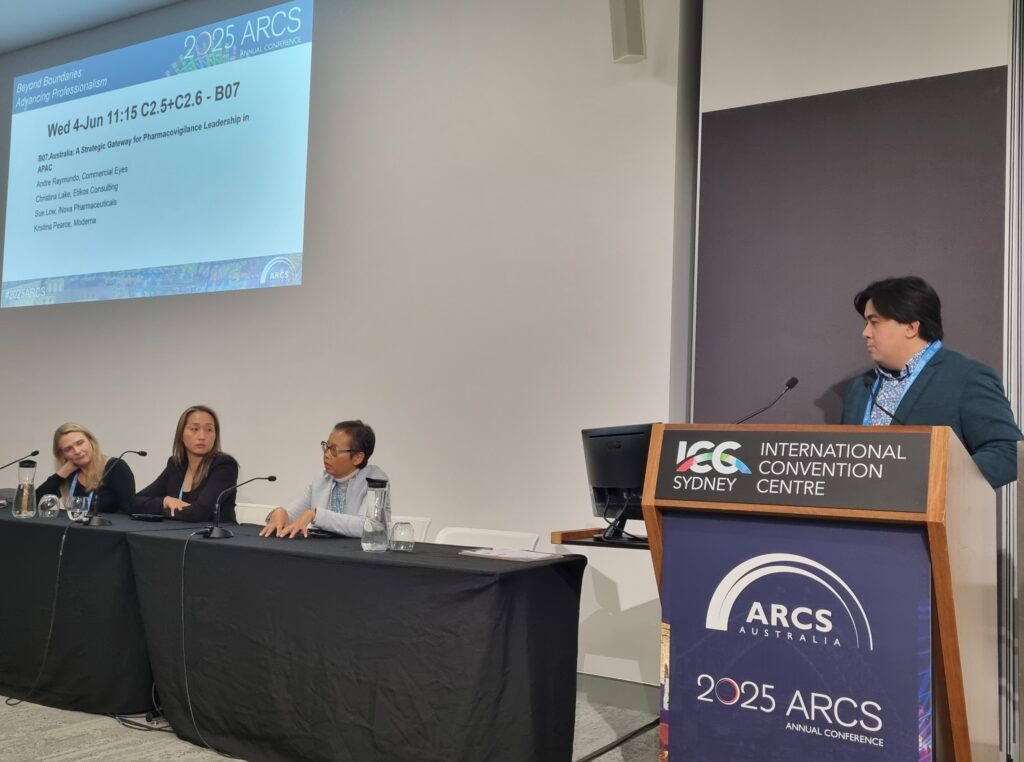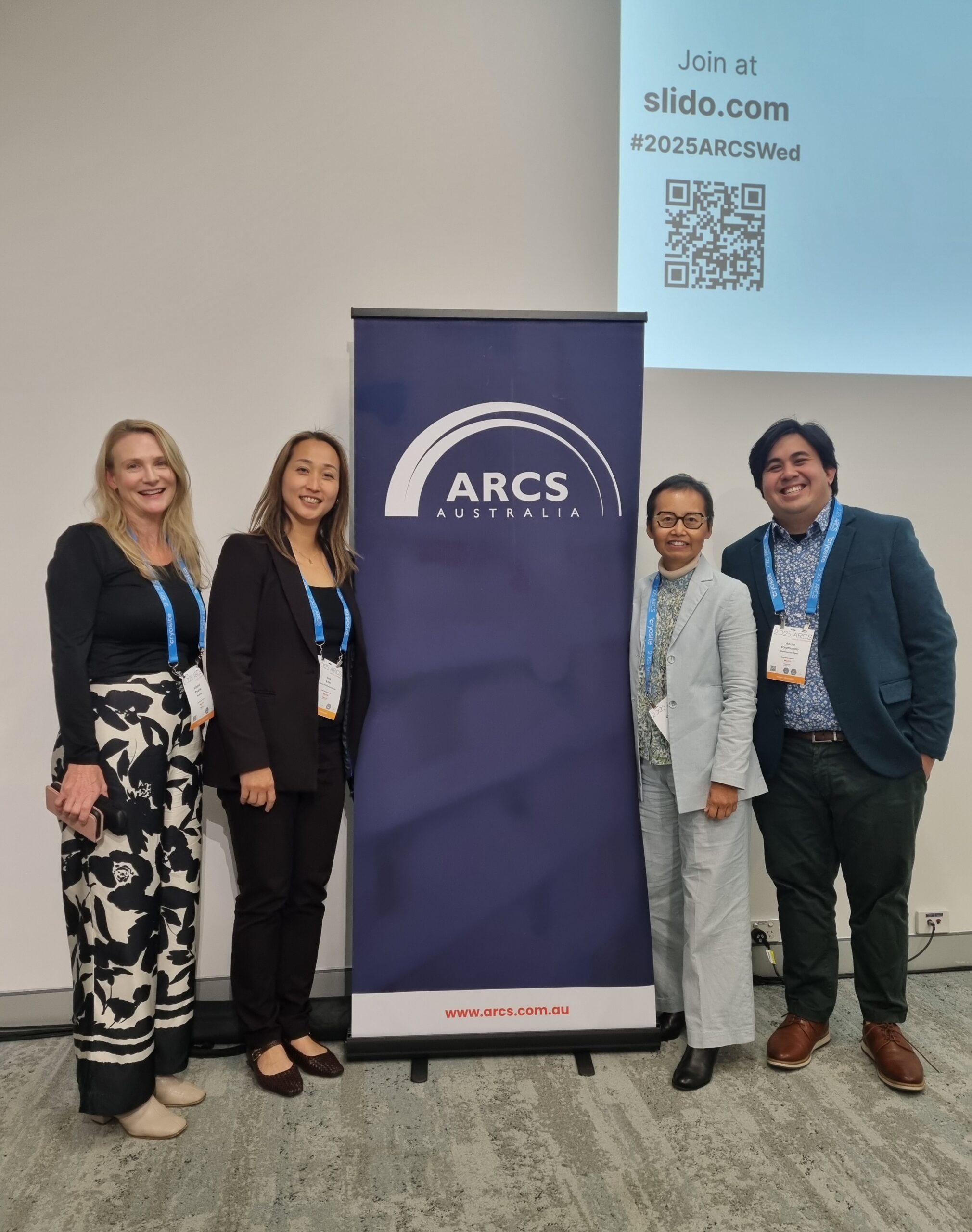At the 2025 ARCS Australia Conference, André Raymundo, Senior Patient Safety Manager at Commercial Eyes, chaired a panel session under the Pharmacovigilance stream titled Australia: A Strategic Gateway for Pharmacovigilance Leadership in APAC.
The session brought together three industry thought leaders:
- Christina Lake (Etikos Consulting),
- Sue Low (iNova Pharmaceuticals), and
- Kristina Pearce (Moderna)
Together, they explored Australia’s emerging role as a hub for pharmacovigilance leadership in the region.
Andre opened the session by outlining how Australia’s well-established regulatory environment, strong academic infrastructure, geographical positioning, global alignment, and cultural diversity uniquely position it as a leader in the Asia-Pacific PV landscape. The session was framed around three facets of this leadership: people, partners and regulations.
People: Strengthening Leadership with Connections, Trust, and Influence
Presented by Christina Lake, Etikos Consulting
Christina Lake spoke about the people aspect of pharmacovigilance through her leadership experience across the region as. She highlighted the complex cultural, linguistic, and socio-economic diversity within APAC and how these factors impact the PV systems in the region. Her key highlights included:
- The impact of pharmacogenetics and pharmacogenomics in the diverse populations across Asia, where genetic variability can affect drug response and drug safety profiles.
- The need for diverse and competent teams to address cultural differences and communication barriers.
- Leadership development with a focus in cultural awareness, understanding commonalities, making meaningful connections, and using language differences as a tool and not a barrier.
“In PV leadership, success isn’t measured by performance alone, but by creating connections, building trust, and influencing others”
added Christina in her closing remarks.

Sue Low focused on the importance of partnerships, both within the company and business partners, in strengthening PV operations across APAC. She acknowledged the complexity of cross-country collaboration, including inconsistent reporting requirements, varied regulatory expectations, and different levels of PV system maturity. She also outlined strategies and shared actionable approaches to enable effective and streamlined collaborations, such as:
- Regional SOP harmonisation and cross-functional training, supported by shared and aligned processes across partners.
- Centralised digital platforms and KPI dashboards that enhance visibility and enable real-time performance tracking.
- Structured governance and feedback mechanisms, including monthly cross-functional syncs and bi-directional communication loops to ensure alignment and continuous improvement.
- The use of an interactive PV Collaboration Frameworks to identify and establish central, regional, and local PV leadership.
“Collaboration should not just be a compliance task, but a strategic advantage”
Sue emphasised.
She challenged us to identify champions, build joint capabilities, and set the tone for a more connected, safe APAC pharmacovigilance ecosystem.
Regulations: Empowering Australia’s Leadership Through Global and Regional Alignment
Presented by Kristina Pearce, Moderna
Kristina Pearce shared her experiences with a regulatory lens, outlining how Australia’s alignment with international standards reinforces its leadership role. She also highlighted several primary drivers that support Australia’s further growth and development in the region:
- Australia is situated in an APAC friendly time-zone with close geographic proximity in the region.
- TGA’s strong and active inspection programs highlights that pharmacovigilance obligations are met and not just merely theoretical.
- Australia’s regulatory framework is aligned with PV norms such as ICH and ISO, and mirrors EU safety reporting constructs.
In addition, comparative insights between Australian and APAC frameworks shows how Australian teams can demonstrate flexibility and leadership in navigating diverse regulatory expectations. For example, Australia’s approach to reporting Significant Safety Issues (SSIs) is comparable to PMDA Japan’s Measures Taken Overseas.
“Australia’s robust regulatory landscape and its alignment to both global and regional standards, is central to being situated as a regional centre for PV in the region”
concluded Kristina.
Looking Ahead
“The panel discussion made one thing clear: Australia is not just participating in the evolution of pharmacovigilance in APAC, it is also a key figure in helping to shape it,” Andre stressed in his closing remarks. From its culturally-attuned people, penchant for strategic collaboration with partners, and robust regulatory framework, the foundations for PV leadership in APAC are already in place in Australia.
Disclaimer: The views expressed in this presentation reflect the personal views of the panel members and do not necessarily reflect the views of the panel members’ employers nor ARCS, nor any other institutions the panel members may otherwise be collaborating with.

